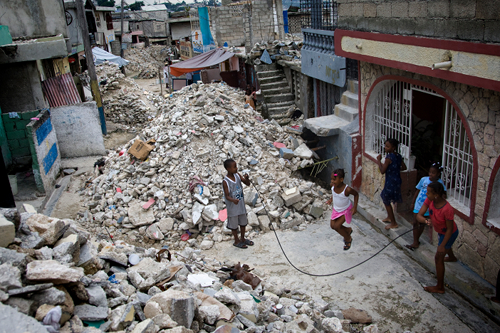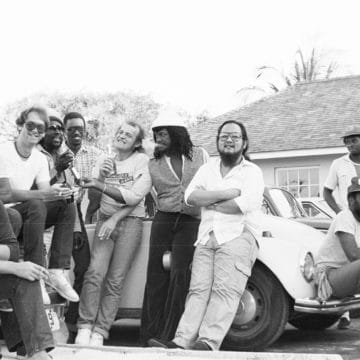Interview with Benjamin Krause, Haiti Director for Sean Penn’s J/P Charity
Above: a street in the town of Delmas 32 in the days after the earthquake. Since 2010, J/P Haitian Relief Organization has cleared 200,000 cubic metres of rubble — and is still doing so. (UN Photo/Marco Dormino)
By Alexander Britell
SOON AFTER the 2010 earthquake in Haiti, Sean Penn’s charity, J/P Haitian Relief Organization went to work delivering aid to the country, first on the streets of Port-au-Prince, and subsequently in the area around the town of Delmas 32. Now, two years after the earthquake, the organization remains on the ground, working not just to deliver aid but help the country recover, with a hands-on philosophy that, it says, emphasizes Haitians first. Indeed, 95 percent of the organization’s employees in Haiti are Haitian nationals. J/P’s activities in the Delmas 32 camp include everything from small business training to a rubble removal programme and, most recently, a project to retrofit homes. To learn more about J/P’s recent work in Haiti and what’s on the horizon, Caribbean Journal talked to Benjamin Krause, Haiti Country Director for J/P about the group’s latest projects, its base around the community of Delmas 32, and the future for J/P in Haiti.
What has J/P been working on of late?
Our primary programme began in relocation management, so it started with about 60,000 people, and it has now gone down to just below 20,000 people. Our team works to ensure the camp is as safe as possible for the families that live there, while also assisting them to return to the neighbourhoods they lived in before the earthquake. So instead of acting as a static entity, we actually manage to help families. The second programme is a medical programme with about 8,000 patients a month, and delivers about 15 to 20 babies a week. It started as a field hospital in a tent started by the US military in the hours after the earthquake, and J/P in inherited that shortly after and operated the clinic. We moved both of those into new permanent facilities in the neighbourhood outside the camp where the residents came from. Another programme is engineering. We have a rubble removal and demolition team that’s been working for more than 18 months, where they’ve moved 200,000 cubic metres of rubble, and on any given day they have up to 700 people working. We provide them a target date on the building they’re going to demolish, and if they demolish it early they get a 6 percent bonus on what they got paid. So we’re able to work faster and more efficiently than anyone else in the field.
What are some of the other programmes?
Another is the community education and life project. We have a school we’ve been operating in the camp, and we doubled enrollment this year up to about 500 students, and just broke ground on a new school that we’re building in the centre of the neighbourhood just outside the camp, so we’ll be able to relocate that school in the coming months. Our community programme works through volunteers: we have a team of about 80 Haitian youths that provide programming and activities for children of all ages, as well as youth and adults, out of our new community centre, which has also recently been retrofitted and opened in the neighbourhood outside the camp. On any given day, we see about 200 students and adults coming for courses – from karate and chess to family planning and ESL. The third part of that is livelihood activities — the largest piece of that is that we assist families to return home – we do follow-up visits with them after two months, if they’re still in the locations where they have moved. We provide another $150 to help recapitalize or start small businesses, and provide them with personal finance training and small business training.
How much change have you seen on the ground since the earthquake?
I mean it’s quite monumental – the scale of change that’s happened over the last two years, for us in particular. The vast majority of our residents come from the neighbourhood Delmas 32, which is just outside of the camp. The only metaphor I can really liken it to is Pompeii – it was a neighbourhood that was quite literally buried completely in the rubble of the earthquake. The streets were buried up to 10 feet high, and we set to work removing the rubble from the streets. It’s a very long and difficult process, because so much of it has to be hand-demolished, and moving rubble bucket by bucket. The local economy is back on its feet, and now we have new construction projects going. Looking at the camp, almost two-thirds of the people living in the camp have now found safe places to return to. The air, the ambience, the atmosphere in the camp is much different – it’s much more hopeful, as people are moving out instead of feeling like they’re just stuck in the mud with no options to move around.
The only metaphor I can really liken it to is Pompeii – it was a neighbourhood that was quite literally buried completely in the rubble of the earthquake.”
How much have you had to adapt the organization as you’ve seen the situation change?
Well, we’re very fortunate, because we’re a very grassroots, very locally-run organization. We’re now over about 300 employees, 95 percent of whom are Haitians, and that puts us in direct contact with the people and the culture and the community. We’ve been extremely agile, and we’ve been expanding in response to the question, “what is needed, what is the obstacle that’s currently standing in people’s way, what is the opportunity that we can help realize for people in our camp and in the neighbourhood?” So just about everything we’ve done has been in response to the needs that were presenting themselves. The organization started as 30 volunteers outside of Haiti coming down to provide emergency medical treatment on the streets in Port-au-Prince, and we’ve grown into a large, quite successful organization working on integrated developments to help support the residents of Delmas 32 to realize durable and prosperous communities. We’ve come quite a long way.
We’re now over about 300 employees, 95 percent of whom are Haitians, and that puts us in direct contact with the people and the culture and the community.”
What has the biggest challenge ahead for the organization and Haiti?
The biggest challenges, I would say, are two fold: one is on the part of Haiti – Haiti needs to find solutions to resolve the issue of land tenure, because it’s so challenging to determine exactly who has rightful ownership of land, and that inhibits our ability to quickly rebuild residences, and it also keeps foreign investment kind of slow to put their money in the country, because they can’t verify if they’re buying a warehouse or an open plot, or a greenfield site – who exactly owns that location and what’s going to happen when they make the first payment? Is someone going to show up that has a claim on that land? Another issue is tracking all the money that was committed to Haiti. It’s been a long period of two years, [with people] saying, well, let’s just wait for the election to happen, wait for hurricane season to pass, and wait for the new government to be installed, let’s wait for the new prime minister to be installed. The government has been very clear that they’re working for Haiti to be open for business, so they need the international community to back them up on that and make good on the commitments that they made.
One of the trends in Haiti seems to be going from relief to more of a “recovery” approach. How much has that been a change for J/P?
I think part of that is that our transition to being a predominantly Haitian organization. I think even more so, is the structure of our organization – with on-the-ground decision-making. Most decisions are made in the country, having someone like Sean Penn, who is a leader who is down here, climbing through the neighbourhoods and seeing what’s going on the ground. Fortunately, we also have the ability of private funding – certainly not on the scale that many of the large NGOs have, but having that private funding and the ability to take risks and show results, and then find institutional donors that will back you up. I think that’s basically the secret to success – local staff, local decision-making and then using private funding to show success as leverage for institutional donors.
What’s on the agenda for 2012 for J/P?
Well, 2011 was all about harmonizing our services between the neighbourhood and the camp. All of the services we were previously covering in the camp, are now completely operational in Delmas 32. This year, we’ll be spending more of our energy working ot support the community in Delmas 32 – not just to move back in, but to revitalize and re-imagine what the community can be. So that’s where I see our plan – supporting that to realize a sustainable and prosperous community in Delmas 32.







